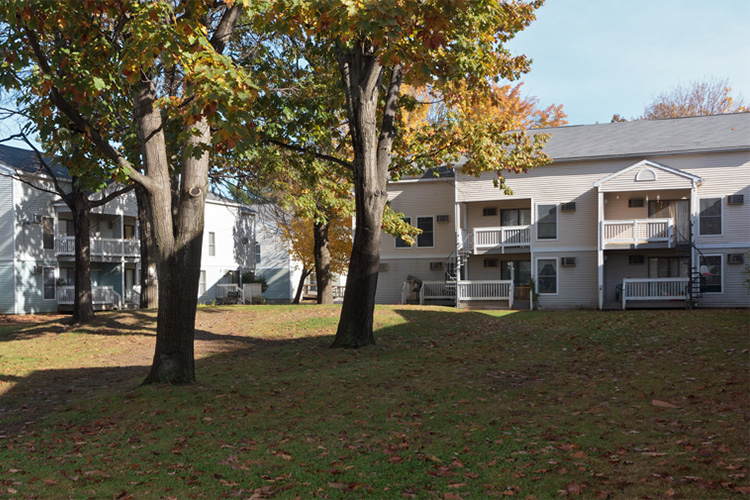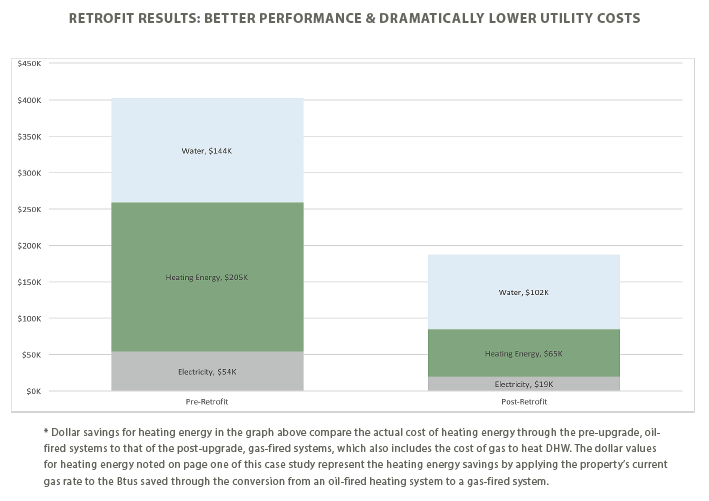250 apartments; 12 low-rise buildings; 246,000 SF; built in 1972
Owned by Peabody-Westfield LP
Managed by Peabody Properties, Inc.
Westfield, MA
The Massachusetts Green Retrofit Initiative (MAGRI) is a project of New Ecology, Inc. (NEI) and LISC Boston. Through MAGRI, NEI and LISC Boston serve as a one-stop-shop to provide holistic energy management services to property owners. This project has been funded by the Barr Foundation and a U.S. Department of Housing and Urban Development Energy Innovation Fund grant.
Deep Retrofit Yields Dramatic Returns

Photo by: Peabody Properties, Inc.
Peabody Property’s energy and water upgrades at Powdermill Village delivered better performance and major savings: they reduced the site’s utility expenses by more than 50 percent.
The large site was a challenging one for the owner. Twelve buildings house 250 families, and each building was heated with a separate oil-fired boiler. Tenants paid to produce domestic hot water (DHW) through electric water heaters in each apartment, a volume of equipment that demanded considerable attention of the maintenance staff. Furthermore, the property is located in an area with a high water table and the buildings’ basements were prone to flooding, which posed a risk to all structures and the mechanical equipment.
Through MAGRI, Peabody Properties asked NEI to conduct an energy audit of the site and to recommend solutions in conjunction with a switch in heating fuels from oil to gas, which would dramatically reduce the site’s operating expenses. NEI prescribed a suite of improvements and oversaw the installation of the upgrades to ensure effective and efficient operations. The oil-fired boiler in each building was replaced with two high-efficiency, gas-fired, condensing boilers with variable-speed pumps to provide hydronic baseboard heating, set by temperature-limiting thermostats in each apartment. A centralized indirect DHW heater made the electric water heaters in each apartment unnecessary, which removed this cost burden from tenants’ electric bills and reduced the burden on maintenance staff. Accompanying the DHW equipment, each building was newly plumbed with well-insulated distribution piping.

NEI also designed and configured a remote, real-time monitoring system to better manage the site’s water challenges and to ensure that the newly installed equipment performed properly. This system generates automated notifications of critical events, such as boiler lockouts or evidence of high water levels in the basements, which help site staff focus on the property’s most pressing needs. Additionally, by monitoring the performance of the heating and DHW systems, NEI determined that the hydronic space heating pumps were improperly circulating hot water throughout the buildings when there was a call for DHW but no demand for space heating, thereby wasting significant energy. NEI informed property management of this problem, who then directed the installation contractor to modify the equipment controls for optimal system performance.
The electrical and water upgrades were similarly comprehensive. Exterior lighting was upgraded from obsolete incandescent and metal halide lights to CFLs and LEDs with photo and occupancy sensors. Old 1.6 gallons per flush toilets were replaced with Niagara Stealth toilets that use only 0.8 gallons per flush, and showerheads that used 2.4 gallons per minute were replaced with 1.75 gallons per minute showerheads in each unit.
The upgrades were funded with $50,000 in incentives from Massachusetts’ low-income utility efficiency program and a $3 million loan from Boston Community Capital, a local community development financial institution, deploying a creative financing package in partnership with MassHousing. The loan will be repaid through the utility savings.
With 12 months of post-upgrade utility data available, the results are dramatic. Across the 12 buildings, electricity use decreased 64 percent and water consumption dropped 29 percent. Heating energy, which compares the energy required to heat the buildings through the oil-fired boilers to that of the new gas-fired systems, decreased 40 percent. These utility performance improvements save the property $118,600 in avoided annual operating expenses.

* Dollar savings for heating energy in the graph above compare the actual cost of heating energy through the pre-upgrade, oil-fired systems to that of the post-upgrade, gas-fired systems, which also includes the cost of gas to heat DHW. The dollar values for heating energy noted on page one of this case study represent the heating energy savings by applying the property’s current gas rate to the Btus saved through the conversion from an oil-fired heating system to a gas-fired system.

